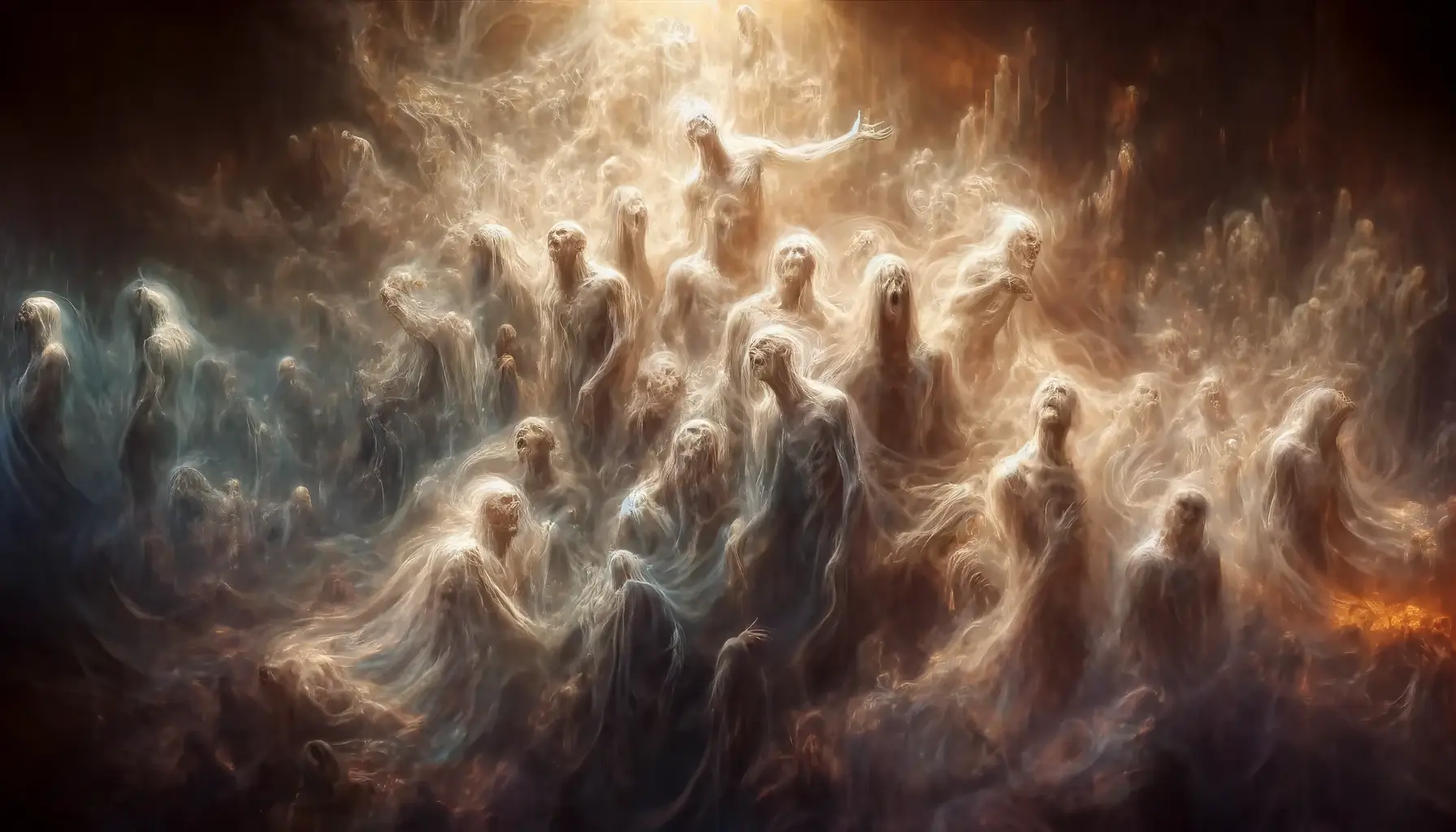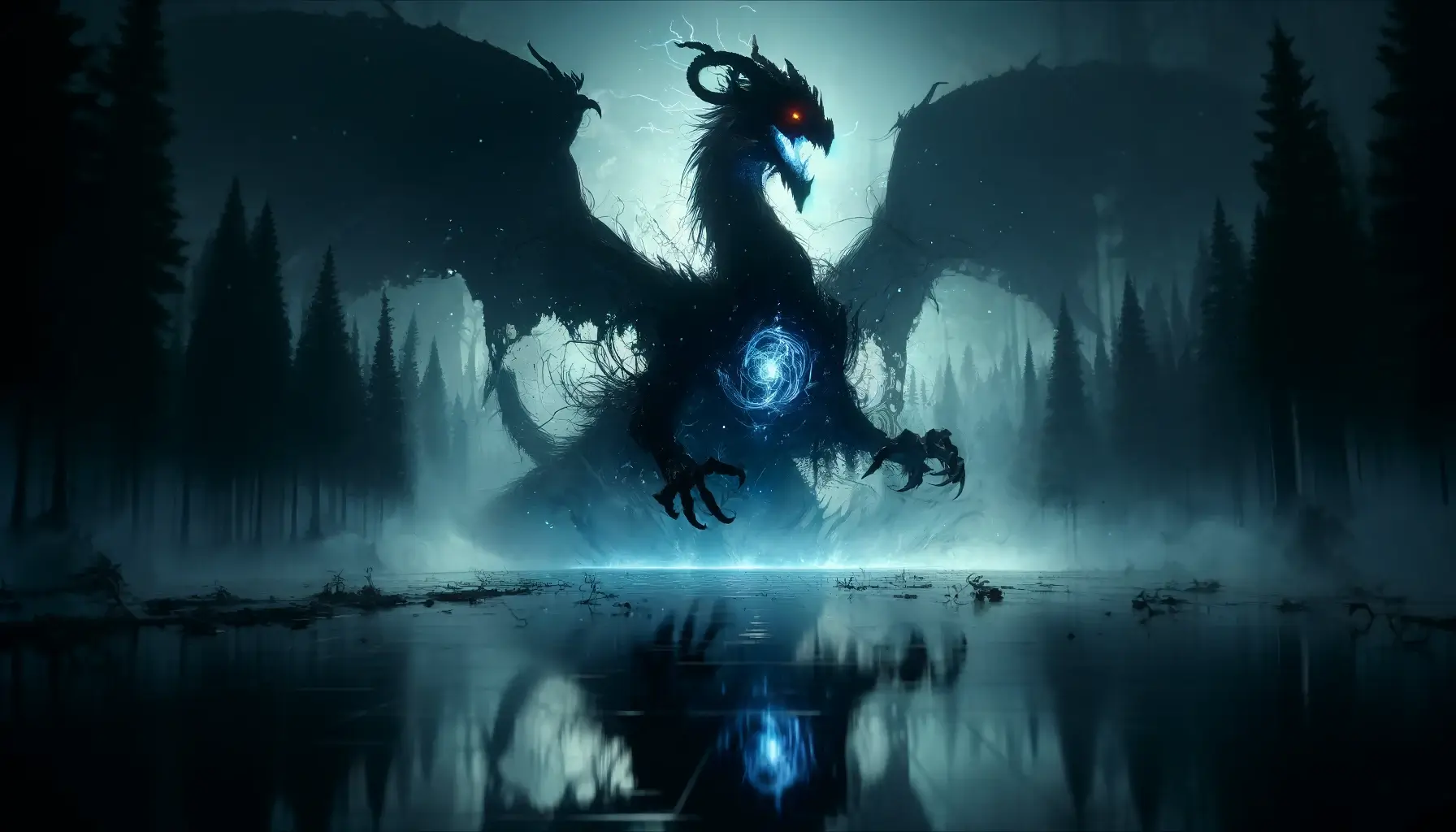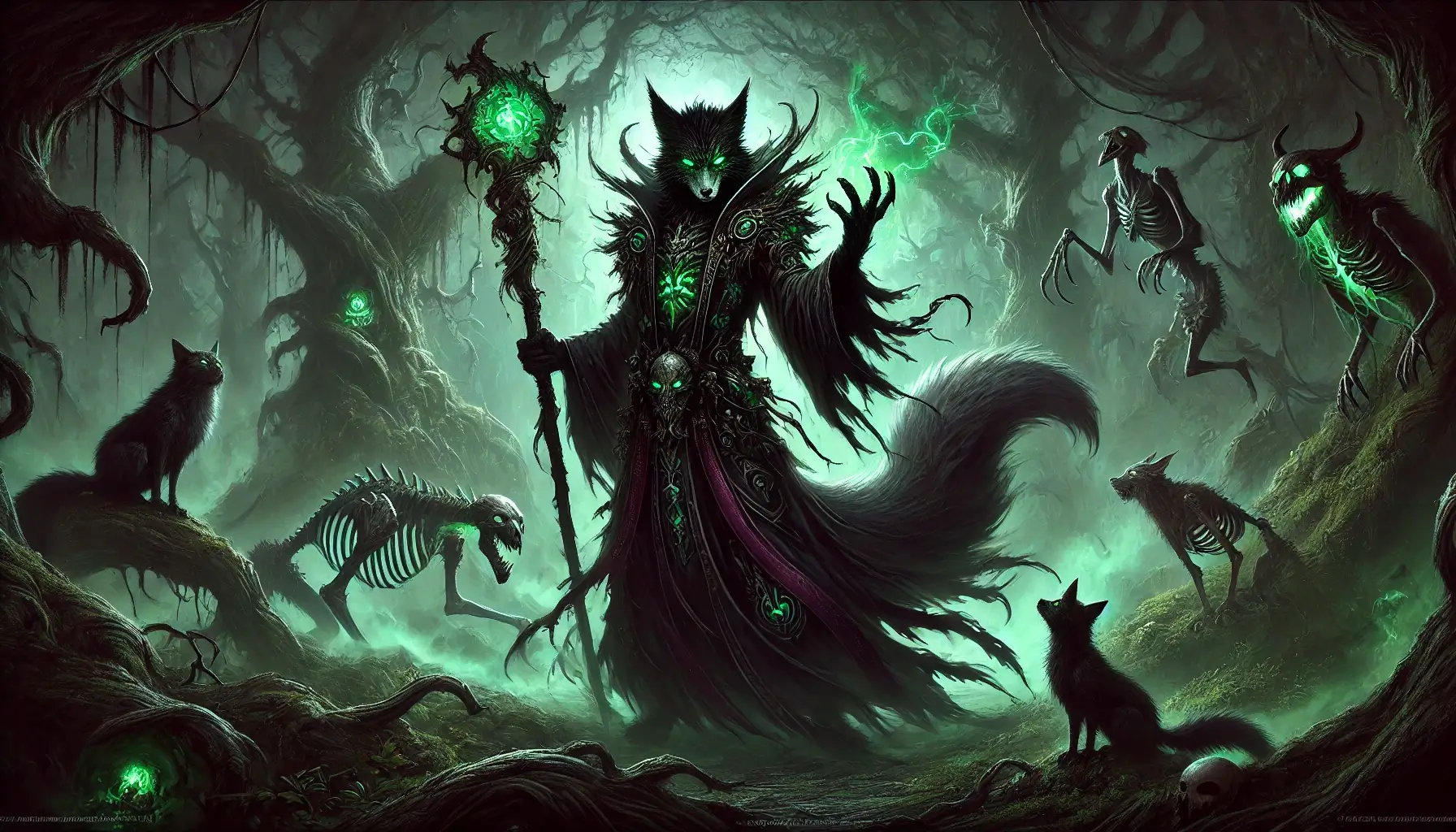Origin: The Grieving Chorus is the coalescence of the restless spirits of a group of people who died under circumstances of overwhelming sorrow or despair. Their anguish fused them into a single, spectral entity driven by a primal need to share their suffering.
The Grieving Chorus could form from various tragedies:
- Cursed Site: The spirits of a village massacred in a brutal attack
- Tragic Disaster: Survivors of a shipwreck or earthquake who perished from shared despair.
- Fell Ritual: The tormented souls of a cult sacrificed in a dark ritual.
Appearance:
- Spectral Forms: The Grieving Chorus appears as a swirling mass of semi-transparent figures, vaguely humanoid in shape. Their features are blurry and constantly shifting with expressions of absolute misery—weeping faces, mouths locked in silent screams, and figures clutching their heads in anguish.
- Woeful Harmony: The Chorus constantly emits overlapping wails, moans, and sobs, creating a chilling symphony of despair that echoes unnaturally.
- Aura of Despair: A palpable aura of sadness and hopelessness surrounds the Chorus, a visible distortion in the air that saps the joy from its surroundings.

Core Concept
The Grieving Chorus is the spectral manifestation of a group of people who perished amidst overwhelming sorrow. Their spirits, unable to find peace, fused into a being driven by a primal need to share their suffering with the living.
Key Features
- Emotional Assault: The Grieving Chorus’s primary weapon is its psychic manipulation of emotions, inducing despair, paralysis, and incapacitation in its victims.
- Spectral Nature: Its incorporeal form grants it unique defenses and movement, but also makes it susceptible to radiant energy and force effects.
- Driven by Anguish: The Chorus is not malevolent in a traditional sense. Its actions are fueled by a twisted need to spread its own overwhelming sorrow.

Stats Suggestion:
- Size: Medium or Large (adjust to impact difficulty)
- Type: Undead
- Alignment: Neutral Evil
- Armor Class: 13 (Natural Armor)
- Hit Points: 90 (12d8 + 36) for Medium, consider 16d8 + 64 for Large
- Speed: 30 ft. (fly)
| STR | DEX | CON | INT | WIS | CHA |
| 8 (-1) | 16 (+3) | 12 (+1) | 10 (+0) | 14 (+2) | 16 (+3) |
- Skills: Perception +4
- Damage Resistances: Psychic, necrotic, poison
- Damage Immunities: Charmed, Frightened
- Damage Vulnerabilities: Radiant, Force
- Senses: Darkvision 120ft, Truesight 60 ft
- Languages: None (understands Common but communicates telepathically)
- Challenge Rating: 5 (Adjust as needed)
Abilities:
- Aura of Anguish: Creatures that start their turn within 30 feet of the Chorus must succeed on a DC 14 Wisdom saving throw or take 5 (2d4) psychic damage and have disadvantage on attack rolls and ability checks until the start of their next turn.
- Wail of Despair: The Chorus releases a deafening wail (range: 60 ft. cone). Each creature in the area of effect must make a DC 14 Constitution saving throw. On a failed save, a creature takes 13 (3d8) psychic damage and is incapacitated for 1 round. On a successful save, a creature takes half damage and isn’t incapacitated.
- Spectral Touch: Melee Attack: +5 to hit, reach 5 ft., one target. Hit: 9 (2d6 + 3) psychic damage. The target must succeed on a DC 14 Wisdom saving throw or be paralyzed by overwhelming sorrow for 1 minute. A creature can repeat the saving throw at the end of each of its turns, ending the effect on itself on a success.
- Consume Joy: The Grieving Chorus gains 10 temporary hit points whenever a creature within 30 ft. of it casts a spell with a beneficial effect or is the target of such a spell.
- Possession (Recharge 5-6): The Chorus attempts to possess a creature overwhelmed by its despair. The target must succeed on a Charisma save or become dominated by the Chorus, acting as an extension of its will.
Social Interaction: The Grieving Chorus is a creature of overwhelming sorrow and has no interest in traditional communication. Powerful magic focused on hope, powerful displays of emotional strength, or spells that directly restore spirits might temporarily deter it or break through its psychic assault.

Lore and Background
Whispers and Folktales: Villages near the Chorus’s haunt might have tales of a chilling wail or unexplained waves of sadness.
- Variations on a Theme: Each village near the Chorus likely has its own version of the tale, changing based on local superstitions and distance from the source. Some focus on a ghostly wail, others on a sudden ‘grey sickness’ causing people to give up hope.
- Children’s Rhymes & Warnings: Parents might use a warped lullaby about the Chorus to scare children into behaving (“Or the Weeping Ones will take you…”). This doubles as a way lore passes through generations.
- Contradictions: Some stories might paint the Chorus as a punishing entity (“They come for the sinful”), others as a tragic consequence (“They came after the Great Fire…”). These discrepancies hint at the true, nuanced nature of the Chorus as a product of sorrow, not judgment.

Lingering Remnants: A scholar might discover records of the tragedy that created the Chorus, hinting at its origin.
- Triggered Visions: The visions occur to characters susceptible to psychic energy or those already burdened with great sorrow. They’re brief, disorienting flashes – weeping faces, a battlefield turning desolate, a sinking ship, etc.
- Ectoplasmic Residue: This requires specific magical sensitivity to perceive. It might appear as shimmering handprints on surfaces, briefly forming words, or leave a lingering chill far colder than the surrounding area.
- Environmental Distortion: Plants wither unnaturally quickly in places where the Chorus has lingered. Animals become skittish or mournful. In extreme cases, temporary spectral figures might form and vanish in the blink of an eye.

Spectral Traces: The Chorus might leave behind faint ectoplasmic residue or cause brief psychic visions of the event of its creation.
- Rumors Lead the Way: Players likely first encounter the Chorus through whispers and legends, pushing them to seek answers.
- Investigation is Emotional: Discovering remnants is not just book research; it involves empathy, handling charged objects, and witnessing unsettling phenomena.
- Piecemeal Revelation: Each discovery is a fragment. The full tragedy and potential ways to confront the Chorus only emerge near the end of the investigation.

Background Notes
- Tragedy, not Evil: Emphasize the Chorus as a tragic entity, not a malicious one.
- Emotional Impact: Encounters should focus on the psychological horror the Chorus brings.
Boxed Text (Read Aloud)
“A mournful dirge hangs in the air, a wave of despair washing over you. From the mist, translucent forms coalesce – faces frozen in eternal torment, their collective sobs echoing like a chilling chorus.”
Here are 3 melodies with short, evocative lyrics to set the mood for the Grieving Chorus:
Melody 1: Haunting Lament
- Style: Slow, mournful minor key melody. Think a single mournful violin or a desolate piano.
- Lyrics:
“Tears fall unseen, sorrow echoes wide, lost souls entwined.”
Melody 2: Dissonant Dirge
- Style: Jarring, clashing notes, almost atonal. Imagine wind whistling through ruins or distorted bells.
- Lyrics: “Hopelessness consumes, joy forever dies, our anguish never lies.”
Melody 3: Whispering Despair
- Style: Ethereal, barely-there hum. A haunting female vocalise or a faint, sobbing choir.
- Lyrics: “Despair takes its hold, a heart forever cold, our cries forever told.”
How to Use Them:
- Entrance: Start with Melody 3 quietly as the Chorus manifests, growing louder.
- Aura: Melody 1 pulses in the background, representing their constant aura of sorrow.
- Attacks: Melody 2 bursts out with its attacks, especially the Wail of Despair.
Encounter Ideas:
Encounter 1 Cursed Ruins: The Chorus haunts the ruins of a once-vibrant city, remnants of a tragedy that wiped out its inhabitants.
Atmosphere: The ruins echo with the Chorus’s mournful dirge. Crumbling buildings lean at odd angles, and traces of the city’s sudden demise remain (abandoned belongings, skeletal remains, etc.). Lingering Tragedy: Psychic remnants of the disaster linger. Characters might experience visions of the event, causing emotional distress or revealing clues to the Chorus’s origin. Guardian of Sorrow: A more powerful entity (a wraith, corrupted guardian spirit) is bound to the ruins, empowered by the Chorus’s despair and fiercely defending its source. Challenges:
- Navigating the dangerous ruins themselves – unstable structures, traps left by the event.
- Overcoming the oppressive emotional impact of the location.
- Battling both the Chorus and any additional spectral guardians

Encounter 2 Desolate Graveyard: The restless spirits of a mass grave cling together as the Grieving Chorus, preying on mourners.
Atmosphere: The graveyard feels unnaturally cold and bleak. Headstones are cracked, offerings withered, and the sense of despair is suffocating. Bound to Grief: The Chorus draws power from the unhealed sorrow of mourners. It manifests more powerfully near fresh graves or during funerals. Spiritual Corruption: The graveyard itself might be blighted. Plants wither, the ground is barren, or minor undead begin to rise bound to the Chorus’s negative energy. Challenges:
- Respect for the dead must be balanced with the need to confront the Chorus.
- Mourners at the graveyard might be vulnerable to the Chorus’s psychic assault and need protection.
- The Chorus could attempt to possess the recently deceased, creating a horrifying spectacle.

Encounter 3 Traveling Spectacle: An accursed traveling bard troupe fell prey to a dark curse, transforming them into the Grieving Chorus and forcing them to sow misery wherever they go.
Atmosphere: The troupe arrives with a deceptive air of festivity – bright costumes, lively music that suddenly turns mournful when the Chorus manifests. Unwilling Puppets: The troupe members are trapped as vessels for the Chorus, moments of lucidity alternating with overwhelming despair. They might plead for help even as they’re forced to perform. Mobile Threat: The Chorus uses the troupe to spread its misery widely. It targets towns with joyous festivals, turning them into hubs of despair. Challenges:
- Separating the individual performers from the Chorus’s influence without harming them.
- The public could be initially hostile, blaming the troupe for the sudden sorrow inflicted upon them.
- Breaking the curse might require a specific ritual or object related to the troupe’s past, forcing characters to investigate while they are constantly under psychic attack.

Quests
Easing the Anguish: Discover the Chorus’s origin and find a way to bring peace to the trapped spirits.
Setup: Legends hint at the Chorus’s tragic origin, perhaps a lost village or a battlefield where a great sorrow occurred. Steps:
- Research: Gather historical records, seek out forgotten lore, or interview elderly locals in nearby settlements. This might involve traveling to a ruined library or deciphering cryptic texts.
- Confronting the Past: Locate the site of the tragedy that birthed the Chorus. The area could be haunted by lingering spectral echoes or protected by environmental hazards.
- Ritual of Release: Learning the truth about the event might reveal a ritual or powerful magic that can soothe the trapped spirits. It could require specific components, words of power, or the act of righting a past wrong.
Complications:
- Residual psychic energy at the site might cause dangerous visions and emotional outbursts.
- Not all the spirits might desire peace; some may be consumed by rage or despair and must be laid to rest forcefully.

Banishing the Sorrow: A powerful artifact is tied to the Chorus, either drawing it to the location or fueling its power.
Setup: Rumors speak of a forgotten artifact steeped in despair, now radiating an aura that draws the Chorus and fuels its power. Steps
- Tracing the Artifact: Legends or historical accounts hint at the artifact’s origins — perhaps a cursed relic from a fallen empire or a powerful sorcerer’s failed experiment.
- Dangerous Recovery: The artifact is likely in a dangerous location — a forgotten tomb, a monster-infested ruin, or in the possession of a malevolent collector.
- Breaking the Bond: The artifact needs to be destroyed or cleansed by a specific ritual. This might require the assistance of a powerful mage or priest.
Complications:
- The Chorus actively defends the artifact, further empowered by its presence.
- The artifact itself might be dangerous to handle, inflicting psychic damage or spreading despair to those nearby.

Beacon of Hope: A powerful cleric or bard, known for inspiring hope, could be the key to driving back the Chorus.
Setup: Stories tell of a revered cleric or legendary bard whose songs carried unyielding hope. This figure is long gone, but their legacy might be the key. Steps:
- Seeking Inspiration: Track down the cleric’s temple or the bard’s place of final performance. There might be clues to their specific methods hidden within.
- An Echo of Joy: A relic exists – a holy symbol, an instrument, or a musical score infused with their joyful spirit.
- Embracing Hope: The characters must not only find this relic but embody the hope it represents. This might involve their personal growth and overcoming their own darkness.
Complications
- Agents of despair might seek to destroy the relic, recognizing its threat to the Chorus.
- Simply possessing the relic is not enough – the characters need to rise to the challenge and express genuine hope, even when surrounded by the Chorus’s aura.

Adventure Plot Hooks
Adventure Plot Hook 1: Blighted Village
- The Hook: Once a bustling community, the village now lies under a suffocating pall of sadness. Crops wither, laughter has ceased, and villagers go about their lives in a daze of misery.
- Investigation: Characters might witness a villager’s sudden emotional breakdown or hear rumors of strange wailing at night. Investigating reveals the Chorus’s influence.
- Challenges:
- The Chorus’s aura weakens the villagers physically and emotionally, making them less willing to help.
- The Chorus might prey directly upon the adventurers, testing their resolve with visions of their own sorrows.
- Discovering the source of the Chorus’s power (a cursed object, a lingering tragedy, etc.) is crucial to ending its influence.
- Rewards: Restoring the village brings grateful allies, valuable information the villagers were protecting, or even a hidden treasure unearthed by returning joy.

Adventure Plot Hook 2: Haunted Journey
- The Hook: A vital caravan route is known for strange occurrences – travelers vanish, become catatonic, or arrive emotionally shattered. This threatens trade or the delivery of critical supplies.
- Investigation: Initial signs might be abandoned wagons, belongings filled with traces of psychic residue, or traumatized survivors with incoherent tales of wailing.
- Challenges:
- The Chorus uses the isolated route as its hunting ground, its power growing with each soul consumed.
- The environment itself could become a challenge, as despair warps reality (mists that lead astray, ghostly echoes).
- Protecting the caravan becomes a physical and emotional struggle.
- Rewards: Success reveals secrets about the Chorus, earns powerful allies among merchants or those awaiting the supplies, and possibly offers loot from previous victims.

Adventure Plot Hook 3: Ritual Interrupted
- The Hook: Characters stumble upon a ritual site – standing stones, macabre offerings, unsettling chanting. It’s clear sinister forces are attempting to draw power from despair.
- Investigation: They might find cryptic writings, learn of disappearances linked to the site, or sense a growing ‘psychic pressure’ in the area.
- Challenges:
- The cultists are fanatical, protecting their ritual with their lives.
- Disrupting the ritual prematurely might release the nascent Chorus in an uncontrolled, even more dangerous form.
- There might be a deeper mystery: who leads the cult, and what do they truly intend to do with a Grieving Chorus under their command?
- Rewards: Stopping the ritual might earn the favor of a powerful good-aligned entity, uncover hidden knowledge, or prevent a far-reaching plan of sorrow from coming to fruition.

DC and Skill Checks
- History/Arcana: DC 15+ to recall tales or knowledge related to the Chorus.
- Investigation: DC 12+ to find spectral residue or clues hinting at the Chorus’s origin.
DM Notes
- Atmosphere is Key: Use sound effects and evocative descriptions to emphasize the emotional impact.
- Tailored Despair: Adjust the Chorus’s targets based on the characters’ backstories and flaws.













